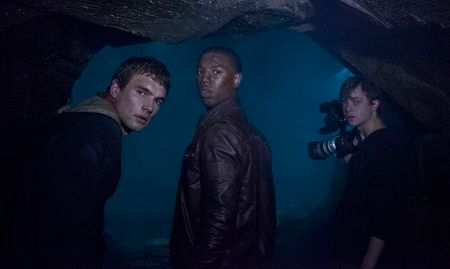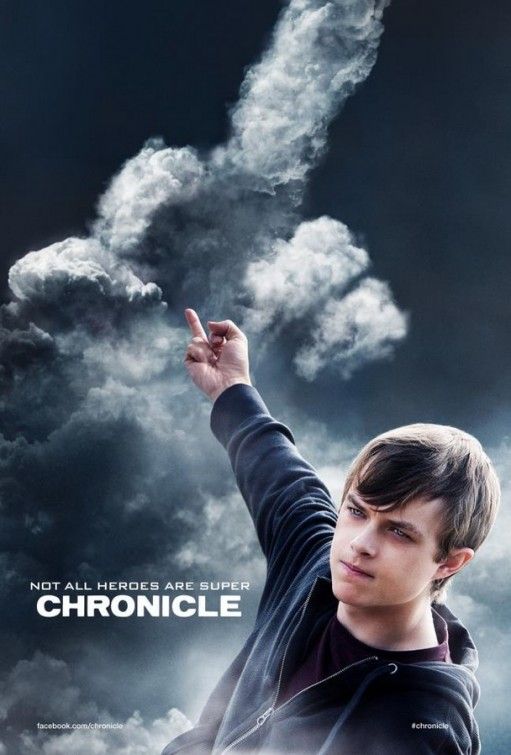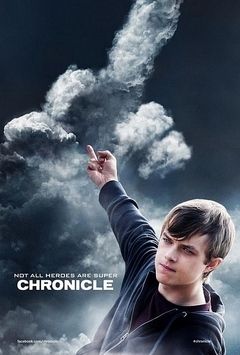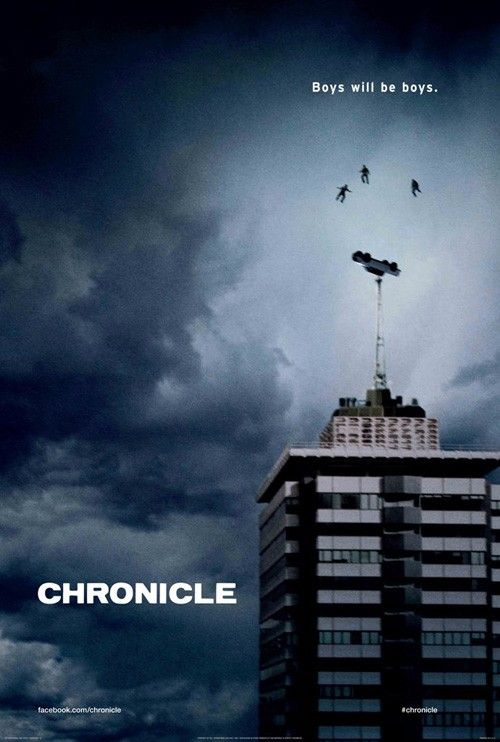Chronicle centers on Matt (Alex Russell), his awkward cousin Andrew (Dane DeHaan), and Steve (Michael B. Jordan). When Matt and Steve discover a bizarre hole in the Earth at a party, they get Andrew, who documents everything with his new camera, to help because his camera has a light. After exploring this hole/tunnel, the group realizes they have been bestowed with telekinetic abilities, i.e. they can move stuff with their minds. While some have gotten a Jackass meets X-Men vibe from the first trailer, I can tell you there's much more to Chronicle than that.
We were shown six clips from the film before Josh Trank and Fox executive Steve Asbell answered our questions. Before the clip, though, we were shown Josh Trank's amazing short film, which was instrumental in getting a green light for Chronicle. The short takes place at a high school house party full of rowdy teenagers, when, naturally, a fight breaks out. A duel, actually, with two kids squaring off using light sabers from Star Wars. When the cops show up, they are actually Storm Troopers, and it seemed everyone in attendance got a big kick out of this short, which I hope is on the Chronicle DVD. The first clip is from the party (in the movie, not the short), and it not only sets up their initial discovery, but establishes some character development as well. The second clip shows the trio with their powers, testing them out in a toy store, which is basically an extended version of the scenes shown in the trailer. However, after Steve moves that red BMW with his mind, we see his nose start to bleed, which can't be good. The third clip shows Andrew and Matt arriving at an abandoned area, looking for Steve, when they realize he is flying above them. The fourth clip is also showcased in the trailer, where Andrew literally pushes a truck off the road, and then they all try to save the driver. They all decide to set some ground rules for their powers, one being that they won't use their abilities on any living thing. However, as we see in the fifth clip, Andrew doesn't quite care for these rules, and uses his gifts to rob a convenience store... while using his telekinetic powers to also film himself with the camera. The final clip shows Andrew has become a force to be reckoned with, as Matt and Steve try to escape from his wrath.
The footage was all rather impressive, especially from a visual standpoint, since this has the look and feel of a $100 million movie, although it was produced for a fraction of a fraction of that cost. Despite the subject matter, these definitely do feel like real kids with unreal abilities, and they do a fantastic job in grounding both the kids, and their newfound talents, while keeping the visual aesthetic very high. After the clips were shown,Josh Trank and Steve Asbell answered our questions. Take a look at the full Q&A below.
This is a lot darker than I anticipated. Do you have an optimistic view of the teenage generation today, because we have one that is very different than previous generations, so was there a certain agenda you wanted to address with this film?
Josh Trank: As far as the modern teenage experience, this movie plays wish fulfillment without any cynicism attached to it. We have these scenes with our main characters out there having fun and doing things, they're doing it without any shame. It's not age-based or generational. If these kids were in their 20s, I think they'd be doing the same thing they're doing here. I wanted to shoot all of these scenes with these actors and keep everyone in the present and in the moment, without doing filmmaker techniques where you overtly foreshadow or try to imply things about the story or theme and just let this play out naturally. When they're having fun and flying, we're up there with them, and when things go dark, they feel very dark because this is what it would be like.
Do we ever see what happens in the cave, or is that left as a mystery?
Josh Trank: We do, and it's pretty cool. It's early on. That clip we showed you, the first clip was leading right into it.
How did this wind up at Fox as opposed to Fox Searchlight or as an independent film?
Josh Trank: When I thought of this, I knew that it had qualities of an indie movie because most of the scenes play out with an understated narrative drive. The quiet moments connect the bigger moments. But at the same time, it has this big blockbuster scope. I thought, personally, it would be the ultimate cool challenge to do this film inside the studio system. (Co-writer) Max (Landis) and I had our own separate reps and it went out to a whole bunch of people, but I didn't know a lot behind-the-scenes. We got the call from (producers) Adam Schroeder, John Davis and Steve Asbell. Max and I went into the studio, met everybody and walked out like, 'F**k!' It was amazing and surreal and it's still surreal now. This was our opportunity to make this movie here at Fox proper.
Has it provided you with the ability to open up the scale a bit?
Josh Trank: I would imagine so, certainly for the ambition of what we were trying to accomplish. We were working with a very, very tight budget. But I think you're going to find that anywhere. The main thing is in studios, there's usually a chance the film is going to be distributed as opposed to with the indie route, it's a lot more vague. I did this film called Big Fan with my friend Rob Siegel and it was $100,000 out of Rob's pocket and two and a half years working on it. It went to Sundance and we waited for distribution. After that experience, I was like we just have to make sure this movie is going to get released. That's the biggest thing.
Can you talk a bit about working with these three young actors?
Why did you set in Seattle, and what setting it in Seattle provided for you, in telling the story?
Josh Trank: I grew up in the '90s, and I loved Nirvana. No, honestly, it was originally set in Portland. I grew up here in Los Angeles, and any place that has seasons, I find fascinating. I've always been fascinated by the Pacific Northwest, and Max happened to be fascinated by it too, so I decided to set it there. When we were developing it internally, Steve said, 'What about the Space Needle?'
Steve Asbell: Anywhere by New York or Los Angeles, I think we've done enough damage there.
Josh Trank: We were trying to think about a city that has something science fiction about it. New York is the place where every big epic superpwer film takes place, or a version of New York City. We didn't want to do that route, we wanted to go somewhere else. Other than some random movie in the '70s where John Wayne plays a cop in Seattle, I couldn't think of any other movie that was set in Seattle, so we were all very excited about it and the set piece we showed you a clip of.
Josh Trank: It started out as a found footage idea because I really wanted to shoot a story that is almost a no-no of found footage. How are you going to go cinematic with this kind of invention? If you had a character that is really visually gifted and can operate his camera telekinetically then, wow, there's a movie there. When I was thinking about scenes in my head, I actually had a hard time imagining what it would look like if the camera was following me around.
Where does the title come from?
Josh Trank: I thought what is this movie, really? I was thinking about the themes and it's kind of a journal, this character is chronicling this. Chronicle just seemed cool and mysterious. It has so much to do with the themes of the film that it should absolutely be called Chronicle.
Steve Asbell: When the title was on the cover of memos, people thought we were doing another Chronicles of Narnia, which was not the case.
What's your take on the superhero films today?
Josh Trank: They're always evolving. Back to Superman up until Marvel's the Avengers and The Dark Knight Rises and this movies coming out this year, there's always surprises. I think it's a filmmaker thing. You get an interesting filmmaker to do a take on characters you loved growing up and obsess over. I think it's always this cool gamble. I'm always for it.
What's the relationship between the two characters in the film Andrew and Matt?
Josh Trank: They're cousins. They have that relationship where Andrew, he's, I hate to use the term, a loner. He doesn't like to be very social, and his cousin is the polar opposite. He's very relaxed, calm and confident. Matt both loves him as a cousin and is annoyed with him, at the same time. He's always obligated to drive him around and do things with him. There's a lot of depth and complexity to that relationship we show in the movie, which is central to everything that unfolds.
Do we get a sense of how long Andrew has been chronicling all this on camera, before the movie starts? Has he been doing this a long time?
Josh Trank: That's a good question. The movie opens up with the first time he has ever turned on this camera. He got his camera, originally, to document what's going on in his home. His mom is suffering from a terminal illness, and his dad has been an alcoholic for many years, and it's been getting worse and worse. He originally starts filming for that purpose, and then it slowly turns into something else.
Josh Trank: We shot the film in South Africa, the whole movie. We met up with this real genius named Simon Hansen and he was a friend of Neill Blomkamp, we had just met him on an interview with local visual FX guys down there. Simon came in and talked about his approach and the way I wanted to do things was keep everything as practical as possible, avoid green screen, shoot - even when we do compositing - real live plates and not create anything digitally. Simon knew how to do all of that. They were pioneers with FX, just real-looking stuff. We collaborated with Simon, brought on a couple of visual effects companies and just looked at every scene and how to avoid digital as much as possible. When Andrew knocks a car through a guard rail, that was just all timing. We had a real stunt driver in a truck, so we shot in the car looking through the rear window. Then we timed cues when he swipes his hand across. And we had a marker with a paper-thin guard rail for the truck to go through. It was a bit difficult for our rotoscopers in some scenes because they would have to remove people. At the end of the movie we have these big scenes where cars are lifting up and on the Space Needle. Obviously, that's not Seattle and we're not in the car, but those are big scenes and the money we had needed to go to those scenes.
When they were flying, were they on wires?
Josh Trank: Actually, we created these big circular rigs that spun and allowed for all sorts of dynamic interaction. Our cinematographer set up all these constantly-moving lights that would represent passing through clouds. That was comped onto a green screen, but we used the practical lighting and all those elements on set, in the digital stage.
What was the budget?
Steve Asbell: We're not going to tell you how much it is, but, honestly, it's way less than you think. It's all on the screen, though, as they say.
You talk about how grounded you wanted it to be, and I was really impressed with the sound, especially with the car being dragged or Andrew crushing the car. How important was the sound to sell these kinds of effects?
Josh Trank: I would say 70% of it. Sound design is huge. This is limited coverage and single-perspective storytelling, and it's often the sounds that you hear off screen, but don't see on screen, which help tell the story. The sound design was so important to this, because it really fills out the narrative.
Are there plans to continue the story of Chronicle? Sequel ideas?
Steve Asbell: Both Josh and Max have a much bigger story involved with this that delves into the mystery of what happens to these characters. This film is about these kids and it has the potential for more. They told me a little bit about it and it's awesome, but we wanted this film to feel like its own piece. It's a really good movie.
Josh Trank: Thank you. I hope you guys like it too.
That about wraps up my coverage from the Chronicle event on the 20th Century Fox lot. This looks like a lot of fun, a movie which balances indie sensibilities with big-budget spectacle, and I can't wait to see how the final product turns out.




